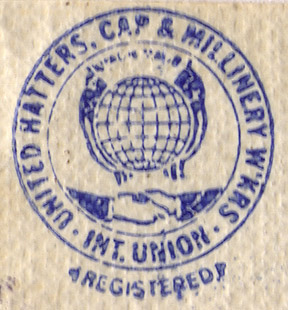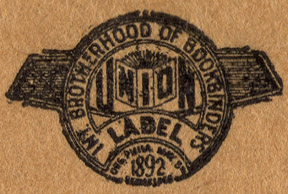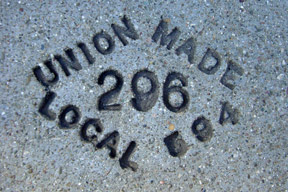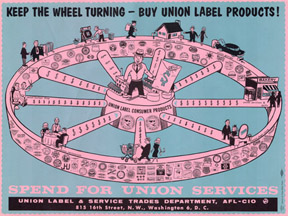University of
California librarian calls for union labels to increase worker
visibility
Archivist wants to see updated, expanded use of graphics to
energize labor movement

This article first appeared in the Nov/Dec 2005 issue of California Teacher, California Federation of Teachers, AFT, AFL-CIO while the author was a member; special thanks to editor Jane Hundertmark.
The American labor movement has been plagued by an “image problem” for a long time, and it’s gotten worse in recent years. Working people, as a class, are largely invisible. Public consciousness of the gains made by working people—gains that benefit the broad social order—are taken for granted or being dismantled.
One way to stake out union turf—that’s as old as organizing itself —is the use of graphics as union labels. All trade unions developed a logo that identified their trade sector as well as organizational name. The logo of the International Brotherhood of Teamsters, formed in 1903 with the amalgamation of the Team Drivers International Union and the Teamsters National Union, still bears two stylized horses, and the International Association of Machinists display the square and calipers of their trade.
Few students going to school are aware that their teachers, or their librarians, or their office clerks are union members.
Some unions were better positioned than others to promote their label by virtue of the nature of their craft: A union butcher might only be able to point to a sign mounted in his shop, while a printer, or cigarmaker, or a garment maker could affix a union label on almost every product that went out the shop door. The Operative Plasterers’ and Cement Finishers’ International Association placed stamps in the sidewalks we use every day, with information not only about the union and local, but the number of the master finisher who handled the work.
The benefits of labeling were numerous. According to the 1957 book, Printers and Technology: A History of the International Printing Pressmen and Assistants’ Union, the union label has at least five purposes:
* It protects against anti- or
non-union shops that might otherwise profess union working conditions.
* It publicizes value to induce customers to buy union-made products.
* It signals good workmanship and quality standards.
* It serves as a badge of union prestige to attract new members.
* It warns against trespass by competitive unions.
These days it’s harder for unions to stamp their work, but it’s not impossible. With all the bad press that organized labor has been getting, one tool that can be used to fight back is expanded public visibility. Few students going to school are aware that their teachers, or their librarians, or their office clerks are union members, except for the occasional strike or labor action. It’s time that we reclaim the turf, and take advantage of every opportunity to let the public know that union members make these institutions work. Members can, and should, add a “produced with AFT labor” stamp on their work (as in example below).
As long
as the union stamp refers to the actual object—a Web page, a classroom
assignment that you’ve copied yourself—this is perfectly appropriate.
It is not right (or legal) to imply union labor for processes
that are not—a handout reproduced at a local Kinko’s should not have
such a label, even if created by a union member.

This distinction is important. It’s long been the case that proper labor practice meant that those wishing to get documents reproduced had four choices:
* Printing jobs at a shop that
uses the label—or “bug”—of the Allied Printing Trades;
*Using a shop with workers represented by a printing trade union such
as the Graphic Communications International Union (GCIU), who use their
own bug;
* Having duplication done by an AFL-CIO affiliate that had in-house
printing capabilities such as the Operating Engineers or the Office and
Professional Employees; or,
* A fallback position of putting a “labor donated” statement at the
bottom.
But times have changed, and the technology and the labor movement are not what they were 50 years ago. The Allied bug was technically supposed to go only on items that are produced from beginning to end with union labor—which included typesetting and camerawork. These days, almost every job run by a commercial print shop arrives as an electronic file with scanned photographs, work rarely done by printing union members—yet the Allied bug goes on the printed piece. The GCIU, suffering declining membership, was recently absorbed by the Teamsters, which is now no longer affiliated with the AFL-CIO.
New tools for content creation and distribution now make it possible for a single union member to create a Web page seen by millions or crank up an office copier and generate hundreds of color flyers. Work like this can and should carry a union label. Expanding the creative use of union labels should be seen as a valuable tool for raising union visibility and rebuilding a labor-friendly environment.
—Lincoln
Cushing has been a librarian at UC Berkeley and was an active member of
his local, AFT 1474 University Council. He previously worked in a union
print shop for almost 20 years. For more information about labor
graphics see
Labor
Culture website.
Other label links:
New
York State Archives
Clothing
labels
Union
label slideshow - Kim Munson
Questions From A Worker
Who Reads
Who built Thebes of the seven gates?
In the books you will find the name of kings.
Did the kings haul up the lumps of rock?
And Babylon, many times demolished.
Who raised it up so many times? In what houses
of gold-glittering Lima did the builders live?
Where, the evening that the Wall of China was finished
did the masons go?
—Initial lines of poem written by
Bertolt Brecht, 1935


Cement finisher's stamp (see
article)

Printing trade label (see article)

All images by Lincoln Cushing.
This poster featured in Agitate! Educate!
Organize! American Labor Posters, Cornell University Press,
2009